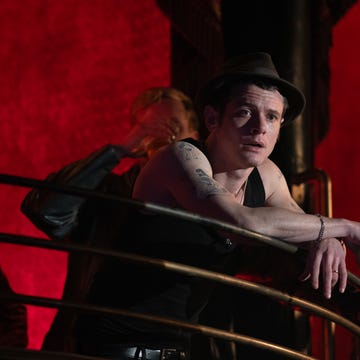You're happily watching a movie, taking everything at face value, having a perfectly nice time, and then Bam! The rug is pulled out from under you.
The unreliable narrator is a classic movie trope, especially one whose cunning ruse isn't revealed until the climax. Time to celebrate the greatest times movie leads totally fibbed to our faces.
WARNING! CONTAINS SPOILERS FOR VERY OLD FILMS!
Memento's Leonard
[asset removed due to syndication rights]A tricksy movie told in reverse, we're piecing together the action along with Guy Pearce's Leonard, a man affected with anterograde amnesia, meaning he's unable to make new memories.
By the end (which is the beginning) of the movie we finally understand that his life-long search for the man who murdered his wife is a lie. He actually found and killed the real culprit years ago and has been used by an undercover cop to off various other criminals who he's manipulated into believing are his man.
The cop reveals that his wife wasn't murdered by a random attacker but that it was Leonard himself who killed her accidentally with an insulin overdose because of his flawed memory. Unable to face this truth, and live with the guilt, Leonard consciously destroys the evidence and choses to carry on hunting a killer who doesn't exist – there by lying to himself (and us by default).
Gone Girl's Amy
Blonde, beautiful Amy (Rosamund Pike) is missing – there's evidence of a struggle and poorly cleaned-up blood stains. Through Amy's diary, which provides the narration in the first half of the movie, we learn of the troubled relationship she had with her husband Nick (Ben Affleck), a selfish and apathetic guy who's been cheating on her – it definitely looks like he's killed her.
Only, in a mid-point switch, it turns out Amy isn't dead at all, and it looks like she's the psycho. The diary, the blood and the struggle were faked just to get back at her rubbish cheating hubby. Deliciously devious.
Life of Pi's Pi
This is a movie about the beauty and nobility in being a massive fibber. Pi and his family are relocating their zoo from Pondicherry to Canada when their boat sinks. Pi finds himself on a lifeboat with a tiger, an orangutan, a hyena and a zebra. As you do.
The hyena kills the zebra and the orangutan, the tiger kills the hyena, and then begins a long stretch of Pi and the tiger lost at sea and trying to survive until they are eventually rescued, with the tiger returning to the wild. It's an uplifting fable of how life, and nature, can be both beautiful and terrible at the same time.
Either that or it's a complete fantasy masking the real story which involved Pi's mother and another sailor being murdered by the ship's chef for food and Pi having to kill him and survive alone. Either/or.
The Usual Suspects' Verbal Kint
Kint (Kevin Spacey) is a con artist so we should know from the outset that he's hardly a bastion of truth-telling, but the way he pulls the wool over the eyes of the audience and the cops leads to one of the most famous movie rug-pulls in history.
Kint narrates the whole story of an underground gangster named Keyser Soze and a heist gone wrong, eventually persuaded to identify Keaton (Gabriel Byrne) as the mythical figure, but insisting he will never testify. Kint is released on bail and only too late do the authorities realise he made the whole story up, even faking cerebral palsy.
By the time they clock that Kint is Keyser himself, he's vanished.
Switchblade Romance's Marie
[asset removed due to syndication rights]This excellent horror movie that came at the peak of the New French Extremity movement features a narrator so completely unreliable that, um, well the movie doesn't actually make any sense.
Marie (Cécile De France) and Alex (Maïwenn) are visiting Alex's parents home in the country when a brutal murderer – a lone trucker – turns up and knocks off her mum, dad and brother, and tries to kidnap Alex. Cue a frenzied cat-and-mouser as Marie desperately tries to rescue her mate while not getting horribly killed herself.
Only, no… that's not what happens at all. In fact, Marie herself is the killer – she's in love with Alex, has offed her folks and kidnapped her herself.
Which makes you wonder what was going on in the scene early in the movie where the 'lone trucker' isn't with the girls and does something despicable to himself with a severed head. Best not think too much about it...
Primal Fear's Aaron
In a weird precursor to the similarly rug-pulling Fight Club, Ed Norton plays a troubled young altar boy on trial for murdering an Archbishop. Richard Gere is Aaron's pro bono lawyer, who thinks he's innocent initially but later comes to believe he's suffering from multiple personality disorder brought on by years of abuse at the hands of the church.
After some cunning lawyering, Gere manages to get his client a not guilty verdict by reason of insanity. It turns out Aaron is kind of insane, but not in a 'not guilty' way – his evil murdering alter-ego is the real him and the poor troubled altar boy was all made up. He's not someone with multiple personality disorder then – just a stone cold psycho.
The Killer Inside Me's Lou
Michael Winterbottom's controversial (but terrific) adaptation of Jim Thompson's novel features Casey Affleck as Lou Ford, a Texas Deputy who is secretly a murderous psycho. And, perhaps unsurprisingly, a total fibber, too.
Ford is a fantasist with a god complex, but it's not till near the end of the film – particularly in the scene where Joyce Lakeland (Jessica Alba) is resurrected from the dead and forgives him for punching her to death in the face – that we realise what we're watching on the screen might not be, yer know, what actually happened.
See also: American Psycho (only more so).














